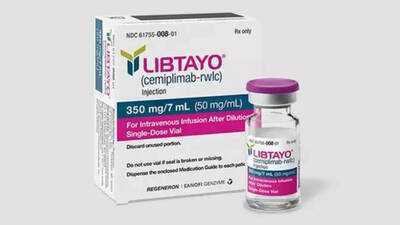
What seems like a turning point in the treatment of skin cancer , the US Food and Drug Administration (FDA) has approved cemiplimab (brand name Libtayo) for helping prevent recurrence of certain skin cancers after surgery and radiation. This marks a promising development in dermatologic oncology, as surgery and radiation alone may not be enough for many patients whose skin cancer might return. The new indication comes after strong clinical trial evidence showing that cemiplimab can significantly cut the chances of the disease making a comeback.
FDA expands use of Cemiplimab: What’s new?
Although cemiplimab was for treating advanced cutaneous squamous cell carcinoma (CSCC) in patients not eligible for curative surgery or radiation, recent developments move it into the adjuvant setting — i.e., as an additional therapy after surgery and possibly radiation to reduce recurrence risk.
Over time, its approvals expanded. In 2021, it was approved for certain locally advanced basal cell carcinoma (BCC) in patients previously treated with hedgehog pathway inhibitors, and accelerated approval was granted for metastatic BCC in some cases.
The latest FDA decision goes beyond treating existing cancer. Now, cemiplimab is approved as an adjuvant therapy – a treatment given after primary therapy (surgery, radiation) to reduce the risk that cancer will come back.
Earlier this year, Regeneron announced results from the Phase 3 C-POST trial: among patients with high-risk CSCC (after surgical removal and radiation), those treated with cemiplimab had a 68% lower risk of disease recurrence or death compared with placebo. The trial enrolled 415 patients and showed a statistically significant and clinically meaningful benefit in disease-free survival (DFS).
Because there was previously no approved adjuvant therapy in this setting, this is considered a major advance for patients whose cancer carries a high risk of returning. The FDA has granted fast-track designations for this indication as of February 2025.

How Cemiplimab works
Now that cemiplimab has shown promise in oncology, it’s important to know the mechanism of the same. How does it work, then?
is a monoclonal antibody that targets PD-1 (programmed cell death protein-1), an immune checkpoint receptor expressed on T cells. In many cancers, tumor cells exploit the PD-1/PD-L1 pathway to “turn off” T cells, evading immune attack. By binding to PD-1, cemiplimab blocks this inhibitory signal — reactivating T cells to recognize and destroy residual cancer cells.
In advanced CSCC trials, cemiplimab showed objective response rates (tumors shrinking or disappearing) of around 41-47% in patients with metastatic or locally advanced disease. Many responses were sustained beyond 6 months, indicating durability.
Importantly, its immune-based mechanism means it does not directly “kill” cancer cells via chemotherapy or radiation; rather, it empowers the patient’s own immune system. That makes it particularly useful in settings where microscopic residual disease remains after surgery — the sort of leftover cancer cells that may later cause recurrence — and conventional therapy may not suffice.
Key benefits, risk factors, and considerations
Benefits
The 68% reduction in recurrence or death in the C-POST trial is a robust advantage in adjuvant settings. It extends the standard of care by giving doctors a tool post-surgery to intercept relapse in high-risk patients, rather than waiting for the cancer to re-emerge. Additionally, because cemiplimab acts systemically, it may protect against both local recurrence (at the original site) and distant metastases. In the trials, reductions were seen in both local/regional and distant relapse.
Possible side effects:
As with other checkpoint inhibitors, immune-mediated adverse events can occur — such as colitis, pneumonitis, hepatitis, endocrine disorders (e.g. thyroid), or skin rash. In the C-POST trial, grade ≥ 3 adverse events were more common in the cemiplimab arm (24%) versus placebo (14%). Furthermore, treatment discontinuation due to adverse effects occurred in ~10% versus 1.5% in the placebo. In addition, close monitoring is required; doctors must balance benefits with risks, especially in patients with autoimmune disease or other contraindications.
Other considerations:
Although the trial shows promise, it is not yet clear how this expanded indication will reflect in guidelines, reimbursement, or real-world access across regions. Hence, longer-term overall survival data are awaited; DFS is encouraging, but the survival benefit must be confirmed. Moreover, the benefit may depend on features like tumor size, nodal involvement, or risk markers (e.g., perineural invasion) used to define “high risk” in the trial.
Video
-
‘Doors Open For Chirag, Kushwaha, Manjhi’: Congress Hints At Talks With NDA Allies In Bihar — ABP Exclusive

-
Farah Khan Reacts To 1987 Dance Video As Backup Dancer In Jalwa. Watch

-
Kerala HC Slams Centre’s Refusal To Waive Debts, Stays Loan Recovery For Wayanad Landslide Victims

-
Odisha: Govt Officials Face Scrutiny For Constructing Tribal School On Forest Land Without Clearance

-
AMMK's TTV Dhinakaran Urges Tamil Nadu Teachers Recruitment Board To Postpone PGT Exam Amid New Syllabus Concerns
